Much of America experienced an intense “polar vortex” this winter; in Michigan, it’s meant a long, harsh season with extreme low temperatures and near-constant snow from the lake effect. It’s affected workers and students, elders who can’t always afford heat, and most especially the homeless LGBT youth of the area. One of their best options — for some, the only option they might have left — is the Ruth Ellis Center, a center for LGBT youth that offers a drop-in center, hot meals, and more. “This time of year we see a huge increase in the need for emergency shelter,” said Mark Erwin, the Ruth Ellis Center’s Director of Community Development. With few shelter beds available in the greater Detroit area, especially for younger single people over the age of 21, the winter is a tough time to survive as a young LGBT person without a stable place to stay.
I visited the Ruth Ellis Center in the middle of December of 2013, when it started to get cold and dark in the early evening, but before the polar vortex killed at least 21 people. It was warm inside the REC’s drop-in center on a weekday evening, where a sign-in desk, cubby wall full of free supplies, laundry room, cyber center, recreational space, and tables surrounded a small, cozy kitchen. But outside, it was frigid; youth picked through a small pile of available gloves and mittens before venturing back outdoors, where you could already see your breath. For confidentiality purposes, none of the REC’s youth are directly quoted in this article; information about their experiences is communicated by staff members who are close to them.
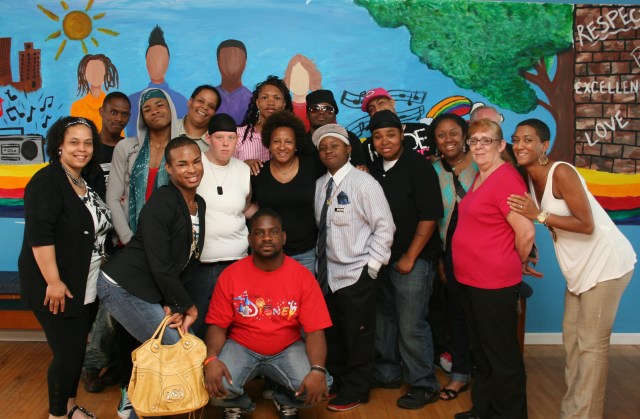
From Wanda Sykes’ visit to the Ruth Ellis Center (photo credit the Ruth Ellis Center)
In order to get there, most of the youth had taken the city bus, which dropped them off at a stop across the street and about half a block down. It didn’t run very consistently or on a reliable schedule. Getting on the bus at all was dangerous and challenging; especially coming from Southwest Detroit, waiting for the bus to the REC meant waiting in an exposed outdoor bus stop for hours — a safety risk many youth couldn’t afford to take. The winter gets brutally cold in the Detroit area, rarely rising above 30 degrees. Along with much of the Midwest, Michigan was subjected to record-breaking low temperatures, with windchill making it feel like 30 to 40 degrees below zero during the day. It was part of the reason that the REC’s list of requested donations included items like winter boots, handwarmers, parkas, new gloves and mittens, and scarves. Despite the transportation challenges, the REC still managed to serve around 500 youth a year, which is about half of what the Center’s Executive Director, Jerry Peterson, estimated to be 1000 or so homeless LGBTQ youth in the Detroit and Wayne County area.
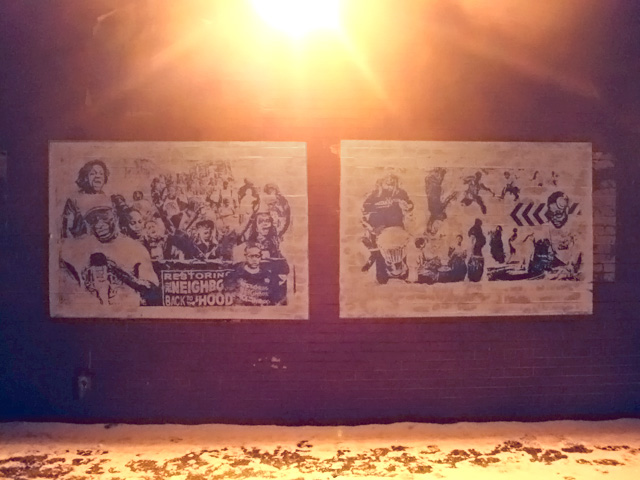
Outside the REC drop-in center
The Ruth Ellis Center was incorporated in 1999 by a group of community activists but its history goes back much further, to 1899, when its namesake was born. Ruth Ellis, a local activist and often considered the first out black lesbian in America, came out in 1915 and lived in Detroit with her partner, Ceciline “Babe” Franklin, from 1936 until her death in 2000. For almost thirty years Ruth’s actual house was a refuge for LGBT black and African-American people, and Ruth also helped many young people through college. It’s appropriate that the center named after such a groundbreaking and heroic woman is also totally unique, the only organization in the country that offers a long-term residential program, Ruth’s House, for LGBT youth in the foster system. Sisters In the Life describes how word of mouth helped turn Ruth and Babe’s house into “the gay spot,” not so different from how youth find the Ruth Ellis Center now:
One would tell another, “I know where you can go. Go to Babe and Ruth’s.” And then they would tell them were we lived and they would come. The house would be full. We had two floors. We had a gay couple that lived downstairs in the little flat. The boys downstairs would open up their place when we had a party so we were downstairs and upstairs and all over the place. I had a big yard. In the summertime, they’d all be out in the yard. We’d have barbeque.
Up to 40% of homeless youth identify as LGBT, and if estimates put the total population of homeless youth somewhere between 1.6 million and 2.8 million, then the number of homeless LGBT youths in the US could be anywhere between 320,000 and 1.1 million. It is especially hard to quantify these numbers because both homeless and LGBT populations are often “invisible,” hard to find or identify for survey research, and youth who are both homeless and LGBT are doubly so. It is similarly difficult to tease out distinct experiences correlating with race or gender, but it is safe to say that experiences of residential instability are appreciably worse for youth of color and transgender youth, groups which often intersect. (99% of the youth who access services at the REC are of color, with the vast majority of those identifying as black or African-American.) Even the word “homeless” is a tricky one; the REC’s documentation will often refer to “residential instability” and include “runaway” and “at-risk” along with “homeless” to describe the youth that they serve. Even if they are not technically “homeless,” there are still youth who rely on a series of friends for a place to stay, or are passed from family member to family member, or who haven’t been kicked out of their home yet but are worried that it could happen soon.
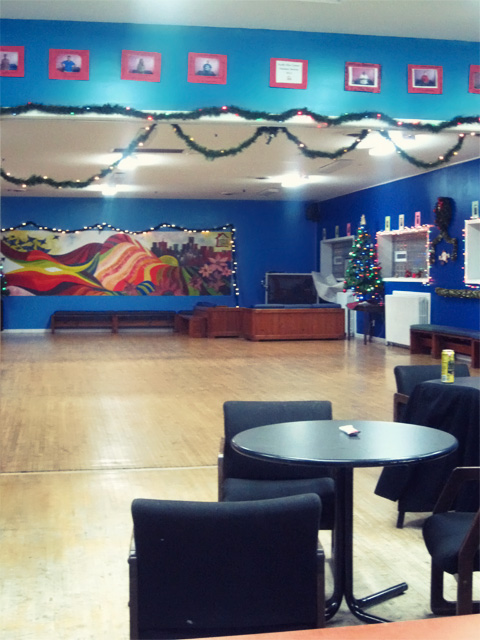
Eating tables and recreation area inside the drop-in center
For these young people, the REC will offer a hot meal and access to showers, clothes, toiletries, safer sex kits, computers, programming and more three times a week at their drop-in center, but not overnight shelter. The Ali Forney Center, a major organization for homeless LGBT youth based in NYC, estimates that fewer than 50,000 homeless young people were able to access shelter last year, which can be deadly in extreme temperatures. In their attempt to find a place to stay, many youth end up in living situations that are unaccepting of their identities and therefore dangerous, like the Ali Forney Center’s Kitt, who experienced physical violence in a group home. Many youth end up engaged in survival sex work in exchange for resources or, more often, for a warm place to sleep. Peterson agrees that “sex work for shelter is actually one of the primary things that [we] see happening.” In 2010, the University of Michigan’s School of Public Health explored the complex realities of survival sex work for trans women, speaking to black trans sex workers Donna, Kelly, Kim, Karyn and Danielle at a motel at Six Mile and Woodward. Many of the women they spoke to had either run away or been forced out of their homes due to family rejection; all of them relied upon the Ruth Ellis Center for a safe refuge and resources. The REC uses street outreach to make contact and build relationships with those like the sex workers at Six Mile and Woodward who might be most in need of their support, but the efficacy of street outreach is always threatened by budget, staffing and resource cuts.
The night I visited, there was little obvious evidence of the challenges the youth at the drop-in center experienced outside the center’s doors. It was lasagna night, and as the kitchen got ready to serve dinner, kids checked Facebook at the cyber center, watched cartoon shows with headphones on, and fooled around at the pool table. The things that differentiated this gathering from a high school cafeteria were small: the thin kid wearing a parka inside who came up, bashful, for a full plate of food three times; the kids who wrapped up food in tin foil or took it away with them in to-go containers. When it first began, the REC didn’t have a policy on to-go food; now, youth are limited to taking one to-go container per person, and they are required to wait to fill up that container until they’re leaving the drop-in center for the night, so that if more youth come in needing dinner, it is more likely that there is enough for everyone. Food-insecure youth may save food to eat themselves later in the week (the drop-in center that serves dinner is only open three days a week) or bring it to friends or family who can’t make it to the center. But the REC has a finite amount of food; even with a church group who comes in and cooks once a month, there’s no way to ensure there will be enough.
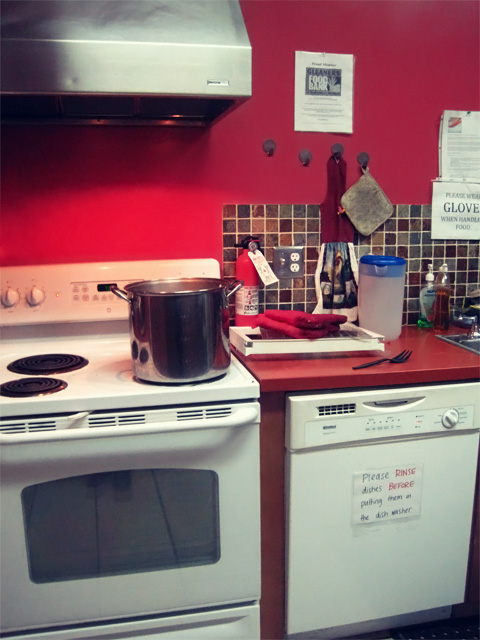
Drop-in center kitchen
The finiteness of resources has remained a constant refrain while looking at realities around youth experiencing homelessness — the fact that in 2002, there were only five shelters specifically for “sexual minority” youth nationwide; that in 2005, there were still only 25; that in NYC, up to 60% of the available beds for homeless youth were at the Covenant House, a facility with documented instances of discrimination against LGBT youth. And all of these are still just transitional living facilities, places where a young person may stay for a time, but not permanently. The Ruth Ellis Center is the only organization in the country with a functioning long-term residential foster care program for LGBT youth; Ruth’s House is a living program that works with the Michigan Department of Human Services, Wayne County Child and Family Services, and other agencies and actually functions as a foster care provider. Ruth’s House also provides life skills, counseling, mental and physical healthcare, job preparation, and aftercare followup. One former resident of Ruth’s House, who happened to be present the evening I was there, had moved from Ruth’s House to their own apartment, and was now planning on moving into the dorms for their first year of college at a nearby state university. There was discussion of moving plans, the need to find some boxes. But even Ruth’s House, with all that it can offer youth in need, has only ten beds.
There have always been a limited amount of resources; the needs of homeless youth, in contrast, will always seem infinite and overwhelming. The only real solution to this problem is to stop it from becoming a problem at all — to step in before youth become homeless. In some cases, this is impossible; when parents become ill or incarcerated or pass on, foster care or homelessness may inevitably be the next step for their children. But when it comes to conflict over sexual orientation, gender identity or gender expression, there’s hope. Family rejection and/or the fear of it is by far the leading cause of LGBT youth homelessness; according to the Williams Institute in 2012, up to 46% of homeless LGBT youth say they ran away from home because of family rejection, and up to 43% say they were forced out by their parents. More than half experienced abuse in their family. These are issues that affect youth all over America, and homeless youth in particular, but are experienced in a particular and devastating way by LGBT youth. When rejection and abuse are fueled by the specific fear of and confusion about sexual orientation and gender identity that many families go through, it’s possible to do something about it.
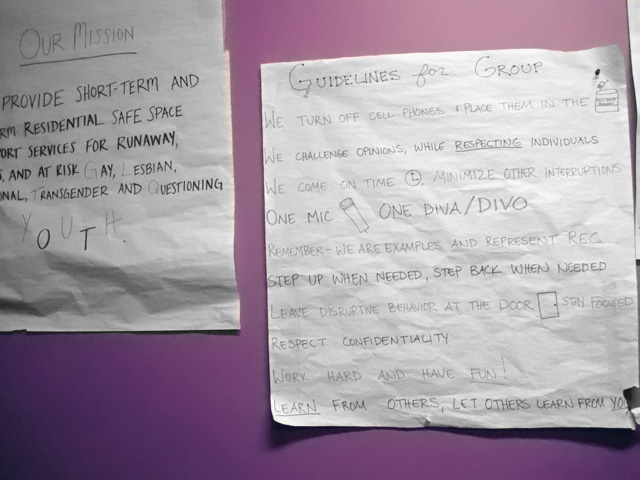
Inside one of the meeting rooms
In addition to having worked directly with family service organizations to set up the long-term residential living situation at Ruth’s House, the REC also works with them to more effectively help families and youth while they’re still in the home. Most Child Protective Services documentation isn’t designed to capture information about sexual orientation or gender identity, and so families in crisis may be passing through the system without those issues ever being addressed. The REC works to train CPS employees to assess whether these issues are at hand in the home. If conflict over sexual orientation or gender identity turns out to be the root of the issue a family is having, the family can be referred to the REC for family group decision making. Over the course of 30 days, the REC works with the family to develop a plan for how their young family member is going to be able to stay in their home. After that 30 days, an advocate is assigned to their home and given 24/7 access for 12 months to support them in implementing that plan. Peterson says, “…in many cases there may well still be tension.” But overall, the goal is “basic safety, reduction in harm, and the ability for a young person to be able to stay in their home with their own family.”
Of course, those goals aren’t always achieved, and of course, many instances of family crisis based in sexual orientation or gender identity never go through CPS, ultimately playing out without any help or support from others. Many kids will end up on the street or in unstable or unhealthy living situations in the coming year. When they do, the REC will offer them more than lasagna and mittens, as important as those are: it will offer a chance to join a community and a culture, and to find pride in an identity that so far may only have brought pain and confusion.
One of the most revolutionary and remarked-upon things about the REC has been their voguing class. It’s managed to make waves with mainstream news like Michigan Radio and NPR. Plenty of people have seen Paris Is Burning, the 1990 documentary that highlighted how NYC ball culture became a cultural touchpoint for gay, queer, transgender, and gender-variant community in the city at the time, many of whom were of color, many of whom left their families of origin and joined new chosen families because of their sexual orientation and gender identity. Not as many people know that the same things still happen, right down to the duck-walking and hand motions and family rejection, right down to the desire to perform something powerful and beautiful in a world that tells you you’re powerless and ugly.
It’s notable that in a building that offers free food, free computer access, free showers, toiletries, and warm clothes, the thing that has gotten most people in the door has been the chance to vogue. The class has amazing word-of-mouth power, and has become a draw for people who might be hesitant to come to the center otherwise. Peterson says that many youth came to the center for the first time to vogue, and that increases their chances of coming back for mental health services, HIV testing, peer community-building, and more. “It’s the low barrier threshold entry point… for young people who have been harmed, rejected, isolated because of their identity for a long time, trust is a huge issue. And for some people, that may be all they ever do. And maybe they’ll come for a few months and vogue and then as they get to know other people and maybe they’ll go to a [peer support] group and they like the group.” In addition to the benefits of drawing youth into the drop-in center, voguing provides an emotional outlet for the often-overwhelming experience of being an LGBT youth. In NPR’s story last year, Matthew said that “One of the emotions that I say I put into my vogue would maybe be anger… I feel like I put it into vogue so I won’t have to put it into other things that are not very constructive.” Youth also worked with fashion students to design their own original outfits and to eventually wear them in a runway show at the fundraising fashion show VOICES.
There’s usually voguing held in the drop-in center on the evenings it’s open; the night I visited, there wasn’t. Someone had broken one of the drop-in center house rules, and so no one got to dance: smooth jazz was put on the sound system instead. Still, when it wasn’t their turn to shoot at pool, some of the kids drifted into the center of the room and practiced squatting to the floor and raising their arms above their heads, or arched their back towards the floor in a controlled fall. They didn’t seem to care if anyone was watching. The room felt empty because many of the youth were in another room in an hour-long peer support meeting. Evidence of the work done in those meetings was all around the center; poster paper with anonymous personal examples of internalized and interpersonal heterosexism. My brother told me I’m going to hell. People assume I have AIDS. I was told I was not a real woman. My aunt told me I should see a therapist when I told her I was trans. Youth in the drop-in center paused when walking by these posters, even if they didn’t attend peer support groups themselves. “They know that their friends made these, people they respect,” says Erwin.
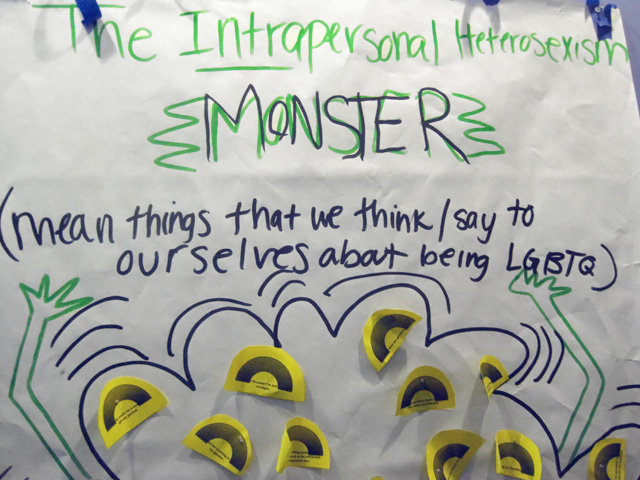
Poster inside the drop-in center
Some of the programming the REC has put together is trans*-specific; it includes education for cis LGB youth and support for trans* youth. “Just because someone is L or G doesn’t mean they know very much about the T,” Erwin says. Emani Love, who first came into contact with the Ruth Ellis Center through utilizing their services when she was a teenager, now works as staff at the drop-in center and runs the programs Trans*Peace and Trans* Just Us. Trans*Peace is a weekly workshop Love facilitates that’s open to trans*-identified people and cis allies. Love says, “My goal with that group is to really create peace among the trans community and [be] constantly transforming our perspective of peace and how that applies to our identity and our personal journey as well as teach allies, people who are non-trans, to be more affirming and supportive of trans* individuals, to reduce stigma and ostracization.” Trans*Just Us is a bimonthly retreat for black and African-American trans women to focus on community, identity, HIV education and prevention, and more. Trans youth make up a disproportionate number of LGBT homeless youth, and trans women in particular (especially trans women of color, which the REC sees much more often than white trans women) are at incredible risk for violence when on the streets without a reliable and safe place to stay. Even within the safe confines of the drop-in center, it’s impossible to forget how dangerous the outside world is — in the window rest framed portraits of women the community has lost.
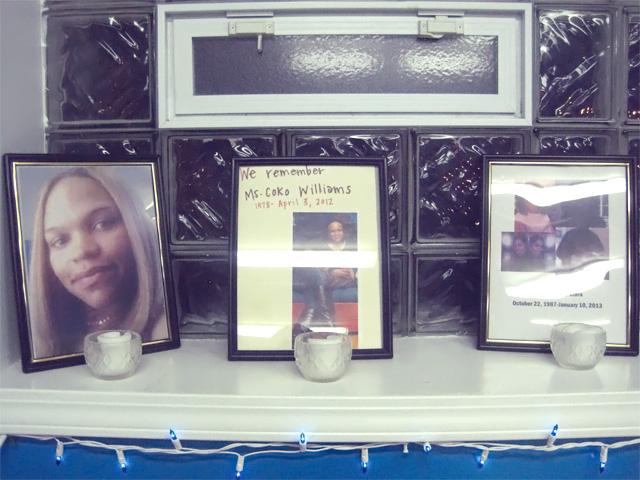
An inside window ledge in the drop-in center
Kids sat around a table just in front of the portraits of the deceased, ate dinner, talked quietly, took selfies in the fluorescent lighting. The peer support group that had been meeting ended; then the room got a little louder and busier, and a few people stopped by the kitchen window for lasagna. It looked a lot like a room full of teenagers hanging out with their friends on a weeknight, which maybe speaks more powerfully to the Ruth Ellis Center’s importance than any other image, and its ability to provide not just a warm room with food, showers and clothing, but a supportive and reliable community of people to fill it.
Of the estimated homeless youth in America, the Ruth Ellis Center and organizations like it can serve only a fraction. Larger institutional recognition of the problem of LGBT youth homelessness is on the rise — in 2011, Obama’s administration put $5 million into a pilot program for LGBT youth in the foster system, a bill regarding LGBT youth homelessness was introduced in Wisconsin in August, and the D.C. council recently passed a bill to better meet the needs of LGBT homeless youth — but on the whole, this is a population that’s being failed on a fundamental level. And despite the purported increase of mainstream acceptance of gay people, the problem of family rejection hasn’t gone away yet. Peterson thinks that with ages of coming out dropping, some problems leading to homelessness may actually be exacerbated: “The reality is, with the average age of coming out in our country now being about 13 and 1/2 coming out to self and about a year later to peers and family, we have now reached a point in our culture where young people at the age of 13 or 14 relying on family of choice is not a viable concept… And that’s just sexual orientation. Children are identifying gender identity questions and issues and expression in grade school.”
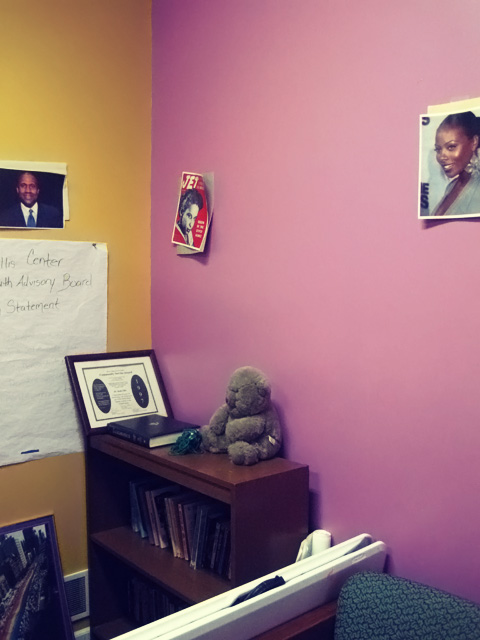
Inside a smaller room used for peer support groups
Even if the numbers seem dismal, however, there was nothing dismal about the inside of the drop-in center that night. Friends hugged hello and shared slices of a spice cake that appeared from somewhere earlier in the evening. The lasagna ran out but there was a pot of chicken noodle soup warming up on the stove in case anyone was still hungry. No matter to what degree the odds are against them, the youth at the Ruth Ellis Center and elsewhere aren’t helpless or doomed. When Peterson talks about the youth he works with, he describes them as “vulnerable,” but also makes sure to add “and resilient.” If there’s anything that spending time at the Ruth Ellis Center makes clear, it’s that the youth it serves don’t need rescuing from anyone else; they’re more than capable of rescuing themselves if we can just give them the resources to do it.
You can make a one-time donation to the Ruth Ellis Center, or make a recurring donation to become one of Ruth’s Angels. You can donate items to the Ali Forney Center via their Amazon Wish List.



Ruth Ellis Center is the best! A model for the rest of America.
Thank you for writing about this! Good article!
Well, fuck. Thanks for writing this, Rachel.
Thanks for writing this, Rachel! I hadn’t heard about the Ruth Ellis Center and it sounds like an incredible and important place.
Incredible work. It’s my goal that once I’m financially secure, either I help out at a local LGBT youth centre, or work towards establishing one.
So happy to see the Ruth Ellis Center to be getting some love and support on Autostraddle. As a native Detroiter and a recent New Yorker, I always wish they would get the same type of national attention as the Ali Forney Center. Both are such important organizations! And I bet that there are a lot more of them across the country that we don’t know about yet.
Thank you Rachel, this is so important!
When I saw the title of this article on Twitter I thought it was going to be about the Whistle Stop Café. I was a bit disappointed when a quick glance at the page told me it wasn’t. But then I started reading and I am so glad I was wrong!
What an amazing place. Thanks so much for sharing their story.
Hi Rachel, this is amazing and so are you for writing it:)
Rachel this was an incredible article.
This was an excellent article. Thank you, Rachel.
Thank you for this, Rachel. They are doing great work there and this article puts it in the greater context of an issue that isn’t talked about enough.
Well this article was the best. What good work is being done there!
It’s always good to read about good people doing good things amid all the bad things that seem all too prevalent. Thanks, Rachel!
What an informative article, thank you for writing and sharing this. Hoping to see more of their great work being highlighted like this.
Just wanted to come back here and say that reading this inspired me to try to look for something closer to me in D.C. — and I found it — The Wanda Alston House, which is run by Casa Ruby, and hopefully I’ll be volunteering a few hours there soon!
This is such important work; thank you for highlighting it and for giving us such a comprehensive look at our youth homelessness, which is, as you say, too often invisible. The focus on the lack of resources is sobering and really resonated with me — I’m definitely inspired to look at how I can contribute to and support this type of work, the REC, and places like it. Thank you, Rachel!
I recently started volunteering for http://www.twenty10.org.au/ which is a similar organisation in Sydney. Folks, if you have the space in your life to do something like this, I highly recommend it! I work with a peer support group, and watching the way these young people stick their necks out for each other is inspiring.
These organisations provide such a vital service, one I bet many of us wish we had when we were young.